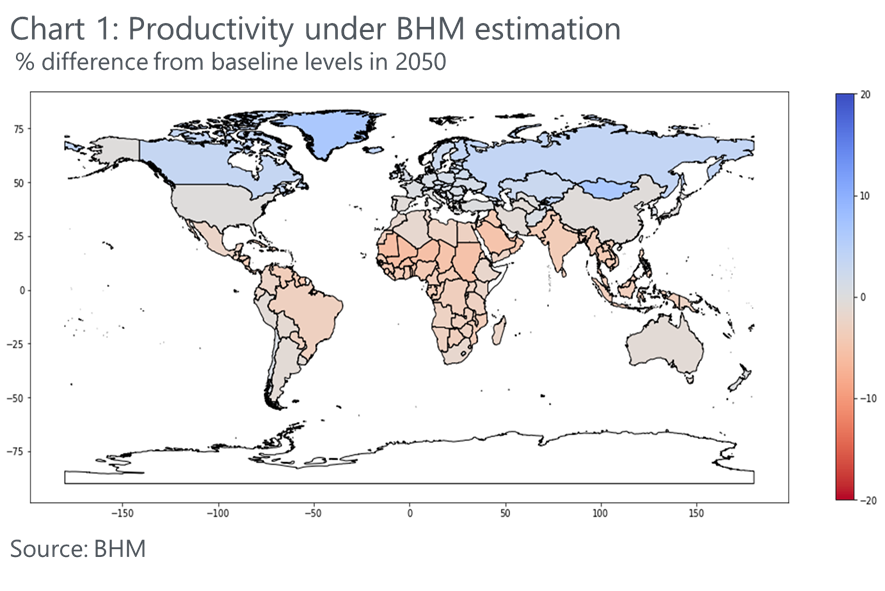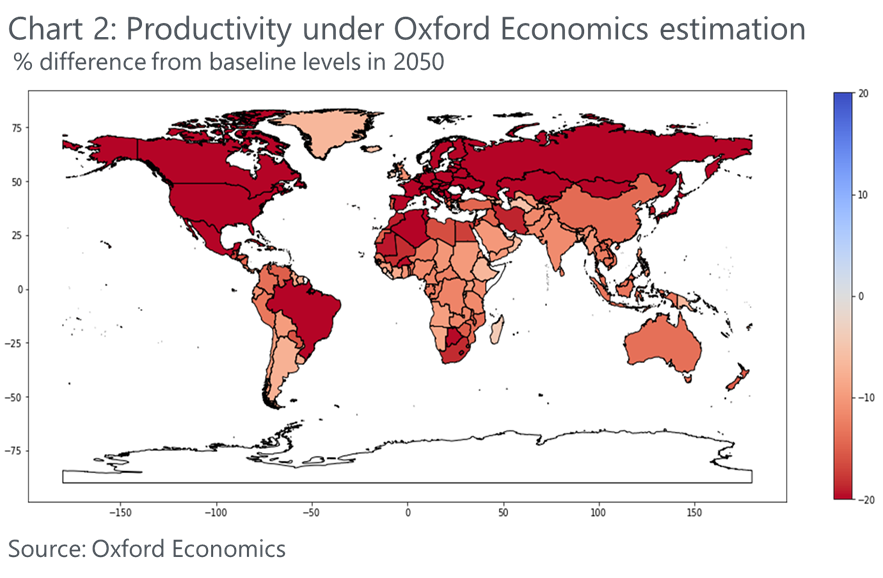Blog | 20 Dec 2022
The global economic costs of climate change inaction

Scenarios & Macroeconomic Modelling
Oxford Economics

Quantifying the economic impact of climate change becomes crucial, particularly in a rapidly warming planet. Record heatwaves are causing crop damage, wildfires, and power outages; they are also buckling roads and runways, and taking lives. At the same time, erratic temperatures are wreaking havoc on production planning and output, especially in agriculture, mining, and construction (Kennet and Marwan 2015, Casanueva et al 2021).
Our recently published research briefing and accompanying technical working paper suggest that the projected economic costs from climate change, calculated using damage functions, are far greater than we had previously estimated. Drawing on pioneering research by Burke Hsiang and Miguel (BHM) that is based on average temperature levels, we initially found that 2.2°C of warming by 2050, relative to pre-warming levels, reduces global GDP levels by only 1%. The economic impacts are largely concentrated in the second half of the century and losers are partly offset by winners. This approach also sees cooler countries initially benefit from modest amounts of warming until they reach an optimal average temperature of around 15°C.
Our new damage function redefines the BHM damage function in terms of warming (that is, the change in global average temperature relative to pre-warming levels). Through this warming definition, it considers temperature anomalies from historical norms, which we show to be more economically consequential than average temperature levels. Our new damage function also accounts for volatility and extremes of the temperature distribution. The resulting estimates show that as the global warming goes beyond its current 1.1°C, productivity growth falls faster worldwide than previously estimated.
Under this new specification, we find that 2.2°C of warming by 2050 has the potential to reduce global GDP levels by up to 20%. Warming of up to 5°C by 2100 would lead to economic annihilation, consistent with scientific research on mass extinction thresholds.
It is also important to note that this estimation suggests that cooler countries, in contrast to BHM (Chart 1), no longer benefit from modest warming. Instead, all countries see significant losses in productivity growth from additional warming (Chart 2). The hit to the global economy would not be evenly distributed across the world. Without climate adaptation, the coolest countries would be particularly negatively affected from climate change, both in the short and the long run.


Our approach assumes no adaptation to climate change. Given that humans have been adapting to their environments throughout history and can be expected to continue doing so, the magnitude of the estimated productivity impacts constitutes an upper bound as adaptation would reduce both the estimates of historic and future projected damages in our model. However, even when we take the 66th percentile of possible damage estimates to allow for potential offset from climate change adaptation, our new damage function still implies a sobering reduction in projected global output of 10% by 2050.
The results underscore the economic costs of climate inaction and, conversely, the importance of climate adaptation and mitigation. While mitigation reduces emissions to address the root causes of global warming, adaptation reduces the future economic damage of global warming.
Author

Manuela Kiehl
Climate Economist, Scenarios & Macroeconomic Modelling
+44 (0) 203 910 8007

Private: Manuela Kiehl
Climate Economist, Scenarios & Macroeconomic Modelling
London, United Kingdom
Tags:
You may be interested in

Post
Greenomics – ep. 2 | To ESRS and beyond: The rise of corporate sustainability reporting
Our blog will allow you to keep abreast of all the latest regional developments and trends as we share with you a selection of our latest economic analysis and forecasts. To provide you with the most insightful and incisive reports we combine our global expertise in forecasting and analysis with the local knowledge of our team of economists.
Find Out More
Post
Greenomics – ep. 1 | Exploring clean energy and the green economy
Our blog will allow you to keep abreast of all the latest regional developments and trends as we share with you a selection of our latest economic analysis and forecasts. To provide you with the most insightful and incisive reports we combine our global expertise in forecasting and analysis with the local knowledge of our team of economists.
Find Out More
Post
Greenomics | A new climate, sustainability and economics podcast
Our blog will allow you to keep abreast of all the latest regional developments and trends as we share with you a selection of our latest economic analysis and forecasts. To provide you with the most insightful and incisive reports we combine our global expertise in forecasting and analysis with the local knowledge of our team of economists.
Find Out More